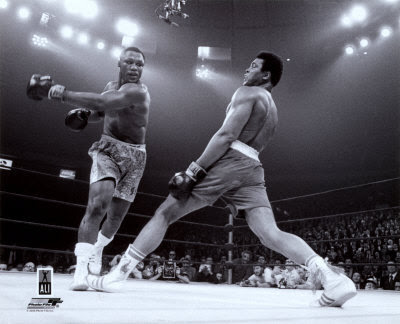Standing tall, at 6-ft, 3-in (1.91 m), Clay had a highly unorthodox style for a heavyweight boxer. Rather than the normal style of carrying the hands high to defend the face, he instead relied on foot speed and quickness to avoid punches, and carried his hands low. However, although he had an impressive record, he was not widely expected to defeat the champ. The fight was scheduled for February 25, 1964 in Miami, Florida, but was nearly canceled when the promoter, Bill Faversham, heard that Clay had been seen around Miami and in other cities with the controversial Malcolm X, a member of The Nation of Islam. Because of this, news of this association was perceived as a potential gate-killer to a bout which, given Liston's overwhelming status as the favorite to win (7–1 odds) had Clay's colorful persona and nonstop braggadocio as its sole appeal.
Faversham confronted Clay about his association with Malcolm X (who, at the time, was actually under suspension by the Nation as a result of controversial comments made in the wake of President Kennedy's assassination). While stopping short of admitting he was a member of the Nation, Clay protested the suggested cancellation of the fight. As a compromise, Faversham asked the fighter to delay his announcement about his conversion to Islam until after the fight. The incident is described in the 1975 book The Greatest: My Own Story by Ali (with Richard Durham).
 Muhammad Ali
Muhammad Ali Muhammad Ali
Muhammad Ali 1970, while his case was still on appeal, Ali was allowed to fight again. On August 12, 1970, with the help of Leroy R. Johnson, a Georgia State Senator, he was granted a license to box by the City of Atlanta Athletic Commission. In Atlanta on October 26, 1970, he stopped Jerry Quarry on a cut after three rounds. Shortly after the Quarry fight, the New York State Supreme Court ruled that Ali had been unjustly denied a boxing license. Once again able to fight in New York, he fought Oscar Bonavena at Madison Square Garden in December 1970. After a tough 14 rounds, Ali stopped Bonavena in the 15th, paving the way for a title fight against Joe Frazier, who was himself undefeated.
1970, while his case was still on appeal, Ali was allowed to fight again. On August 12, 1970, with the help of Leroy R. Johnson, a Georgia State Senator, he was granted a license to box by the City of Atlanta Athletic Commission. In Atlanta on October 26, 1970, he stopped Jerry Quarry on a cut after three rounds. Shortly after the Quarry fight, the New York State Supreme Court ruled that Ali had been unjustly denied a boxing license. Once again able to fight in New York, he fought Oscar Bonavena at Madison Square Garden in December 1970. After a tough 14 rounds, Ali stopped Bonavena in the 15th, paving the way for a title fight against Joe Frazier, who was himself undefeated.Ali and Frazier met in the ring on March 8, 1971, at Madison Square Garden. The fight, known as "The Fight of the Century," was one of the most eagerly anticipated bouts of all time and remains one of the most famous. It featured two skilled, undefeated fighters, both of whom had legitimate claims to the heavyweight crown. Frank Sinatra—unable to acquire a ringside seat—took photos of the match for Life magazine. Legendary boxing announcer Don Dunphy and actor and boxing aficionado Burt Lancaster called the action for the broadcast, which reached millions of people. a disease to which those subject to severe head trauma, such as boxers, are many times more susceptible than average. Despite the disability, he remains a beloved and active public figure. In 1985, he served as a guest referee at the inaugural WrestleMania event. In 1987 he was selected by the California Bicentennial Foundation for the U.S. Constitution to personify the vitality of the U.S. Constitution and Bill of Rights in various high profile activities. Ali rode on a float at the 1988 Tournament of Roses Parade, launching the U.S. Constitution's 200th birthday commemoration. He published an oral history, Muhammad Ali: His Life and Times by Thomas Hauser, in 1991. That same year Ali traveled to Iraq during the Gulf War and met with Saddam Hussein in an attempt to negotiate the release of American hostages. Ali received a Spirit of America Award calling him the most recognized American in the world. In 1996, he had the honor of lighting the flame at the 1996 Summer Olympics in Atlanta, Georgia.
The Muhammad Ali Center, alongside Interstate 64 on Louisville's riverfront
He appeared at the 1998 AFL (Australian Football League) Grand Final, where Anthony Pratt invited him to watch the game. He greets runners at the start line of the Los Angeles Marathon every year.
In 1999, the BBC produced a special version of its annual BBC Sports Personality of the Year Award ceremony, and Ali was voted their Sports Personality of the Century receiving more votes than the other four contenders combined. His daughter Laila Ali became a boxer in 1999 despite her father's earlier comments against female boxing in 1978: "Women are not made to be hit in the breast, and face like that... the body's not made to be punched right here [patting his chest]. Get hit in the breast... hard... and all that.






No comments:
Post a Comment